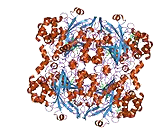Erythrocyte Catalase (EC)
HEC; Human Erythrocyte Catalase

Mammalian erythrocytes have large amounts of catalase, an enzyme which catabolizes hydrogen peroxide (H2O2). Because catalase has a low affinity for H2O2, others have suggested that glutathione peroxidase clears most H2O2 within the erythrocyte and that catalase is of little import. erythrocyte catalase might function to protect heterologous somatic cells against challenge by high levels of exogenous H2O2. whereas nucleated cells are readily killed by an enzymatically generated flux of superoxide, the addition of human and murine erythrocytes blocks lethal damage to the target cells. Inhibition of erythrocyte superoxide dismutase, depletion of glutathione, and lysis of the erythrocytes do not diminish this protection. However, inhibition of erythrocyte catalase abrogates the protective effect and the addition of purified catalase restores it. Furthermore, erythrocytes derived from congenitally hypocatalasemic mice do not protect L1210 cells.
